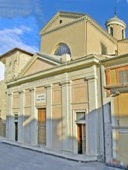
The church was temporarily closed after the earthquake of 2016, and the relics of the Blessed Angela of Foligno, as well as those of the Blessed James and Philip, are now housed in the adjacent Oratorio del Gonfalone, at which the friars of San francesco officiate.
San Matteo, Porta San Matteo and Palazzo Imperiale
The Friars Minor of Foligno took possession of two buildings on this site in 1255:
-
✴A certain D. Rodolphus donated to them the small ‘private” church of San Matteo. The 17th century scholar Durante Dorio recorded that this church had been built in 1095, although the earliest surviving documentary reference to it dates to 1226. (This church is described by Guerrini and Latini, referenced below, at p. 311, entry 96).
-
✴Pope Alexander IV authorised them to take possession of the adjacent ‘palatium curiae ... quod imperiale vocatur’ (i.e. the so-called Palazzo Imperiale), which had previously served as the public palace of the Ghibelline administration.
Another bull of 1256 allowed the friars to build a new church and convent on this site.
A noblewoman, Margherita di Filippo Ofreduti, endowed the new foundation in her will, which was drawn up in 1256 ‘in palatio quondam communis Fulginei ubi nunc est ecclesis fratrum minori’ (in the palace that once belonged to the Commune of Foligno, where now is the church of the Friars Minor).
-
✴The new church incorporated San Matteo as a chapel to the right of the presbytery.
-
✴Palazzo Imperiale was demolished to make way for the adjacent convent. It is possible that the medieval remains that have been unearthed in the cloister belonged to it. (See Guerrini and Latini, referenced below, at pp. 315-6, entry 104 and pp. 323-4, entry 120).
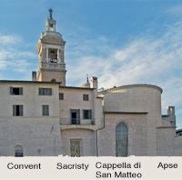
Rear view of the church and convent
This construction project required the demolition of a short stretch of the original city wall that included Porta San Matteo (see Guerrini and Latini, referenced below, pp. 319-20, entry 111). This gate was first recorded in a document published in 1256 that described the confines of the new Franciscan complex (quoted by Guerrini and Latini at p. 103), which also mentioned the new city walls and associated carbonarie (defensive ditches). [The closed arch of the Porta San Matteo survives in the wall of the sacristy, as illustrated by Vladimiro Cruciani, referenced below, at p. 98, Figure 72.]
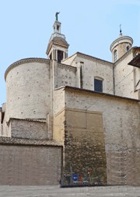
Blessed Paoluccio and the Observant Franciscans
The Blessed Paoluccio, who was a nephew of Ugolino II Trinci (died 1353) and a cousin of his successor, Trincia Trinci (died 1377) became a friar at San Francesco in ca. 1350, when he was about 14. He was closely associated with the minority of the friars here who favoured the reform of the order. In 1368, Trincia Trinci seems to have facilitated the transfer of Paoluccio and a few like-minded friars to the hermitage at San Bartolomeo di Brogliano, probably so that they could escape the moves against the fraticelli that Pope Urban V had initiated in 1365. The community at Brogliano became known as "the brethren of the family of the observance", or the "Zoccolanti" (because they wore wooden clogs).
Over the next 25 years, Paoluccio developed the nucleus of what was to become the the Observant congregation of the Franciscan Order. He was finally persuaded to leave Brogliano in 1390, when he was old and nearly blind, but insisted on walking the 20 miles to San Francesco. He died here in 1391. In his work “La Franceschina” (15th century), Giovanni Oddi says that Paoluccio was buried with honour at San Francesco. A number of documents written at this time specify that his grave was in the orchard here.
Just before Paoluccio died, Ugolino III Trinci had given him a fortress on the outskirts of Foligno. Paoluccio’s successor, Fr. John of Stroncone built the church and convent of San Bartolomeo di Marano on the site in 1408-15 for the more “observant” members of the community at San Francesco. This complex formally transferred to the Observant congregation in 1450.
The friars at San Francesco and San Bartolomeo retained close ties throughout the 15th century. However, strains began to emerge in 1502, when Cardinal Domenico Grimaldi warned former not to impede the tradition by which friars from San Bartolomeo heard Easter confessions in San Francesco. These tensions must have been exacerbated after the formal split of the Franciscan Order in 1517, albeit that the Observants continued to hear Easter confessions at San Francesco until 1586.
Mario Sensi (referenced below) suggests that the body of the Blessed Paoluccio would have been unwelcome in San Francesco in this deteriorating climate. In his “Umbria Serafica” (1670), Agostino da Stroncone claimed that the friars here secretly transferred it to the remote church of San Salvatore di Verchiano, outside Spoleto. (The sarcophagus that apparently contained it survives there, although the body itself is now in San Francesco di Monteluco).
Later History
The present campanile was built to the right of the presbytery (i.e. to the left of it when viewed, as here, from behind) in 1911.
The church was rebuilt in 1796-1856, to a design by Andrea Vici. The façade, which was finally completed in 1886, never received the planned portico.
Convent
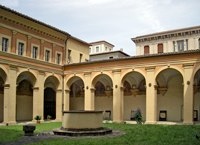
As mentioned above, the convent was built on the site of the old Imperial palace. It was suppressed in 1860 and adapted as a barracks.
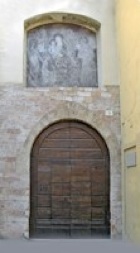
Madonna and Child with saints (1499)
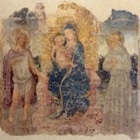
Crucifixion (14th century)
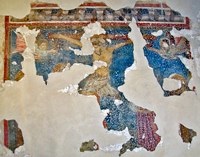
This damaged fresco is on the back wall of the old Chapter Room.
Interior of the Church
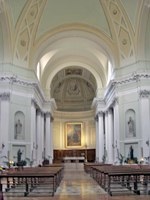
The original church was in the form of a Latin cross. A second nave was built to the left in the 14th century to accommodate a series of interconnecting family chapels. It owes its present appearance to the rebuilding of 1796-1856.
Altare della Beato Angela daFoligno
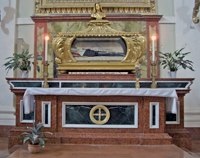
The relics of the Blessed Angela of Foligno are venerated on this altar (the 2nd altar on left). [They have been temporarily transferred to the Oratorio del Gonfalone while the church is repaired after the earthquake of 2016.]
Vision of Blessed Angela of Foligno (ca. 1791)
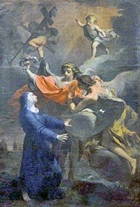
Altare della Beato Angelina da Montegiove
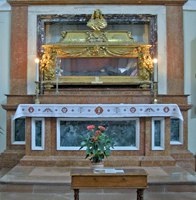
The relics of the Blessed Angelina of Montegiove are venerated on this altar (the 2nd altar on right).
Vision of Blessed Angelina of Montegiove (ca. 1796)
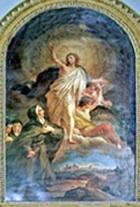
Relics of Blessed James and Philip
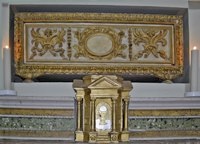
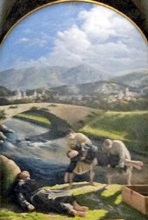
The sarcophagus above the 3rd altar on the right contains the relics of the Blessed James and Philip, two Franciscans who tried to persuade the rebellious people of Bevagna to make peace with Foligno in 1377. Trincio Trinci, Lord of Foligno, accused them of treason and had them executed in the main piazza of Bevagna. Their bodies were thrown into the Topino, but miraculously floated back to Foligno. They were recovered from the river there and translated to San Francesco. [They have been temporarily transferred to the Oratorio del Gonfalone while the church is repaired after the earthquake of 2016.]
The modern ceramic altarpiece above the altar depicts the recovery of their bodies from the Topino after their martyrdom.
Cappella di San Matteo
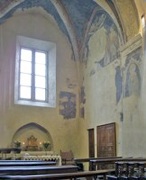
This important chapel at the head of the right aisle can be visited on request at the adjacent convent. It is formed from the original church of San Matteo and a contiguous space to the right.
Way to Calvary (ca. 1400)
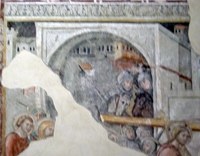
This fresco, which is attributed to the Maestro dell' Abside Destra di San Francesco di Montefalco, is to the right on the right wall.
Crucifixion with saints (14th century)
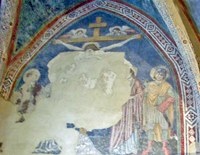
This fresco is high up on the right wall, above the door to the sacristy. It depicts the Crucifixion with the Virgin, SS John the Evangelist and the kneeling Mary Magdalene, with a Roman soldier to the right.
Bishop saint (14th century)
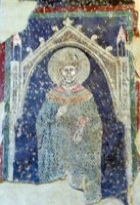
Votive frescoes (14th century)
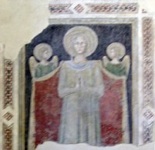

These frescoes on the right wall depict:
-
✴the Assumption of the Virgin; and
-
✴St Catharine of Alexandria.
Franciscan saints (14th century)
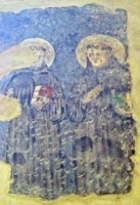
Male saints (14th century)
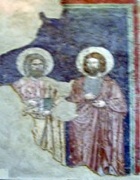
Fresco fragment (14th century)
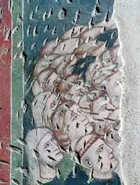
Votive frescoes (14th century)
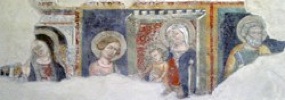
These frescoes on the back wall depict:
-
✴the Virgin Annunciate;
-
✴the Mystical Marriage of St Catherine; and
-
✴St Peter.
SS Sebastian and Roch (1496)
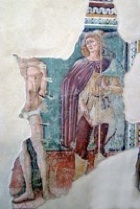
Art From the Complex
Rose Window (13th century)
This small window from the original church was installed above the portal in the facade of San Francesco, Gubbio, in 1958.
Frescoes (late 15th century)
Two detached frescoes from the Chapter Room, which attributed to Pierantonio Mezzastris, are now in the Pinacoteca Civica:
Madonna and Child with St Simon (late 15th century)
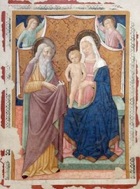
Madonna and Child with saints (late 15th century)
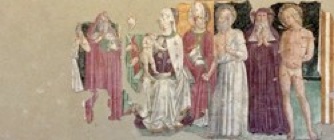
This detached fresco, which is attributed to Pierantonio Mezzastris, depicts the Madonna and Child with:
-
✴a lost saint, a fragment of Blessed Peter Crisci, St Jerome as a cardinal and St Catherine of Alexandria on the right; and
-
✴SS Blaise, Jerome as a penitent, Bonaventure and Sebastian on the left.
Read more:
P. Guerrini and F. Latini, “Foligno: Dal Municipium Romano alla Civitas Medievale: Archeologia e Storia di una Città Umbra”, (2012) Spoleto
V. Cruciani, “Mura e Città: Il Caso di Foligno nel Trecento”, (1998) Foligno
Return to the page on Monuments of Foligno.
Return to to Walk II.



